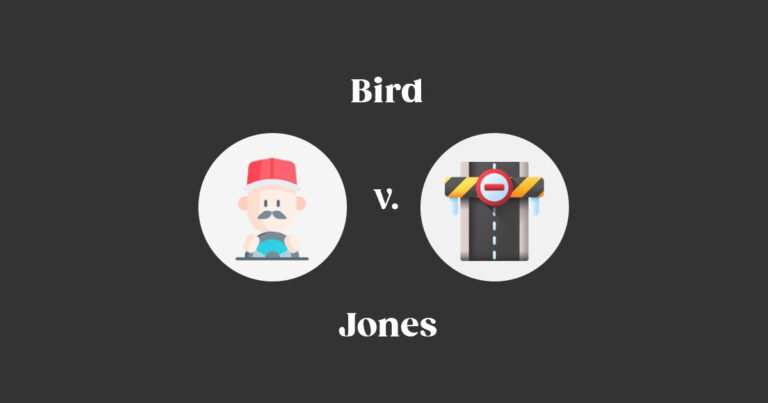Quick Summary
Bird (plaintiff) attempted to enter a portion of a state highway that Jones (defendant) had closed off for spectators to sit during a boat race. Police officers, at the direction of Jones, prevented Bird from entering.
However, Bird was not physically restrained and was free to move in any other direction except along the highway. Bird alleged assault and false imprisonment and brought a lawsuit against Jones.
The issue presented to the court was whether blocking a road falls under false imprisonment.
Facts of the Case
Mr. Bird (the plaintiff) was traveling on a highway and encountered an obstruction caused by Mr. Jones (the defendant), who had closed off a portion of the public road for a boat race. This portion of the highway was designated for sitting to those willing to pay for a view of the race.
Bird attempted to enter this area but was confronted by Jones. There was a struggle between the two, during which Bird was not momentarily detained or physically restrained, but he managed to climb over the enclosure.
After Bird successfully climbed over, Jones stationed two police officers to block Bird’s passage in the direction he desired to go.
These officers obeyed Jones’ instructions and prevented Bird from proceeding forward along the footway. However, they informed Bird that he was free to return to the footway and proceed to the other side of the bridge if he wished.
Bird refused this alternative and chose to remain where he was despite having the option to move freely in any other direction.
Procedural History
- Mr. Brid sued Jones for assault and false imprisonment.
- Jones claimed self-defense for the assault, saying the plaintiff assaulted him before the imprisonment.
- The plaintiff responded with a replication de injuria, arguing that the defendant falsely imprisoned him without lawful justification.
- At trial, the jury ruled in favor of the plaintiff for the assault but against the plaintiff for false imprisonment.
- Unhappy with the false imprisonment verdict, the plaintiff appealed to the King’s Bench for a reversal of the lower court’s decision.
- King’s Bench granted the appeal.
I.R.A.C. Format
Issue
Does obstructing a person from moving in one direction constitute false imprisonment when all other directions are open?
Rule of Law
False imprisonment is a restraint on a person’s liberty without lawful justification or authority, whether by confinement in a physical space or forcibly detaining the person against their will. To constitute false imprisonment, there must be a total restraint of a person’s liberty, not just a partial obstruction or disturbance.
Reasoning and Analysis
The majority opinion reasoned that false imprisonment requires a bounded area, tangible or intangible, within which the party imprisoning would confine the imprisoned party and prevent them from leaving.
The defendant, in this case, only prevented the plaintiff from continuing in one specific direction, which does not constitute false imprisonment. False imprisonment requires a total restraint on a person’s liberty, and in this case, the plaintiff had the option to go back in the opposite direction or choose an alternative route.
Therefore, the obstruction and prevention did not amount to false imprisonment.
Conclusion
The High Court concluded that there was no false imprisonment in this case. The plaintiff was not completely confined or restrained and could go in any other direction.
Key Takeaways
- False imprisonment requires a complete restraint on a person’s liberty.
- Partial obstruction or prevention does not amount to false imprisonment.
Relevant FAQs of this case
Is using physical force or restraint necessary to be charged with false imprisonment?
No, physical force or restraint is not always necessary to be charged with false imprisonment. False imprisonment can also occur through the use of threats or intimidation.
- Example: A store owner locks a customer inside a room after accusing them of shoplifting, despite the customer’s protests of innocence. This constitutes false imprisonment, even though no physical force was used.
What kind of evidence must be presented to establish a false imprisonment claim?
To establish a false imprisonment claim, the plaintiff must provide evidence that they were confined against their will within a bounded area, either physically or by the threat of force. This can include witness testimony, video footage, or other physical evidence.
- Example: If security guard wrongfully detains a shopper for suspected theft, the shopper can present surveillance footage from the store as evidence that they were confined without justification.
Was this case brief helpful?
